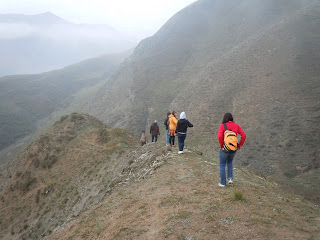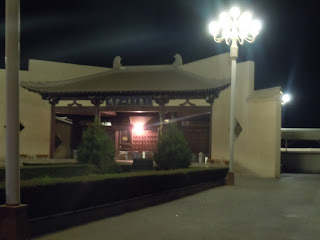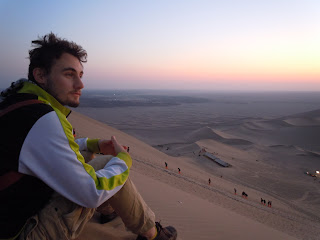The exciting conclusion to the Silk Road journey! (I apologize again that this has taken so long to post – I just have been caught up in the day to day routine and preparing for our midterm on Friday and working out our independent travel weekend plans. Hint: I’m going to see the monument of China.)
From Dunhuang we took a train into Lanzhou, the capital of Gansu province; after resupplying ourselves with snacks, we jumped on the bus for our roughly five hour ride into the highlands. Although we technically never left Gansu, much of southwestern Gansu and much of Qinghai province are historically Tibetan areas and therefore are inhabited by Tibetan people, their yaks, and dotted with Tibetan Buddhist monasteries. We had some free time to wander around our new home, Xiahe 夏河, and then went to eat dinner with our Alliance classmates from Beijing. It was nice to see them all again, though I had forgotten a lot of people’s names (and even some people’s faces!). Luckily, a lot of them had also forgotten us, so no harm. Perhaps the most exciting part was after dinner when our hosts constructed a bonfire and began dancing around it. Some friends of mine and I naturally had to join in. They also shot off some fireworks and we had a singing contest; the Tibetans won hands-down, though we found out our RD has a really good singing voice.
Taken from the bus, a scene of the rolling hills at sunset
Fairgrounds where we ate dinner with the Beijing
We walked around the other side of the hill and climbed our way up. We did literally had to climb on all fours for some parts because of the steepness and muddy footing; luckily, the plants are extremely well rooted and even long blades of grass could hold my weight as I climbed. The view from the top was spectacular, especially as the morning fog kept dissipating as the sun rose higher and warmed up the city. Descending was obviously a lot easier than ascending, though there were still some iffy spots; everybody made it down injury free.
View from the hilltop
Beginning our descent from Sky Burial Mountain
Mani stone on the side of the road
Alongside the road we saw two interesting trinkets placed inside holes in the hill face. One of the types were called chatchas which were small clay Buddhas or stupas which apparently were prayers for protection. The second type were mani stones, named because of the famous six-syllable Tibetan prayer to Avalokitesvara, a Buddhist Bodhisattva of compassion. After rejoining our large group for breakfast, we bid farewell to our Beijing friends and headed to the main attraction of Xiahe: Labrang Monastery 拉卜楞寺.
Main entrance to Labrang Monastery
To our surprise, the
Inside the monastery, you are not allowed to take any pictures inside the temples as they house Buddhist statues; photography is thought to take away from the spiritual energy of the statues besides being a respect issue. The monastery is comprised mainly of buildings for education and living spaces; Tibetan Buddhist monasteries are almost as much colleges as they are places of worship. Monks typically will spend at least thirteen years in their discipline and then “graduate” with a doctorate in whatever subject they were studying, which all are highly integrated with Buddhist philosophy and Tibetan culture. We did see a good number of child monks, probably as young as ten or twelve, who were rather active and energetic and running around the grounds, which was a bit of the contrast to the solemnity of the inner sanctums of the temples.
Picture with some monks excited to take pictures with foreigners
Courtyard where educational debates are held
Large stupa inside the monastery
Without delving too much into all of the information we learned about Tibetan Buddhism, there are a few different sects, the largest of which is the Geluk-pa or “Yellow Hat School
After lunch, we headed back into the hills for a short horse ride and traditional Tibetan snacks. The horses are much shorter than the European variety we’re used to; however, it made mounting and dismounting a lot easier. We split up into two groups to take turns riding the horses. Although I had never ridden a horse before, these horses were not only highly domesticated (though they sometimes tried to push each other and one time even kicked another horse!) but also there was a fence on either side of us making it impossible to get lost. After riding, we had a snack of hot yak milk with yak butter for extra flavoring. I think partially because I had been playing with my nose a bit to imitate the little girl walking around, I got my third (but final) nosebleed of the trip.
All saddled up and ready to go!
During the second group’s horseback ride, it started raining, which did make the walk back to the bus rather muddy, but also created one of the fattest rainbows I have ever seen. Unfortunately rainbows don’t really turn out on cameras.
Karen, Andras and I were then accompanied by our guide back to the monastery to hopefully catch part of a debate (debates are apparently a large part of the learning style). Although we had missed the debate, we were fortunate enough to see a farewell ceremony for some of the monastery’s Living Buddhas. Living Buddhas are reincarnations of high-ranking lamas but not necessarily people who have reached nirvana. The method of blessing was rather peculiar: monks had bowls of orangish liquid which they would drink and then spit out into the crowd. The liquid is apparently some form of Tibetan medicine that is supposed to resemble (and perhaps contain?) blood and thus connote longevity and vitality.
Monk (notice the yellow hat!) blessing Buddhist adherents
Monks learning sutras through recitation
The next morning we had another optional morning walk. This time only Andras and I were interested to go; we visited another temple (Gong Tong Pagoda) outside the monastery that had some of the most ornately carved wooden gate frames I have ever seen. The inside of the temple was also a bit different than the ones inside the monastery: there were a lot more Buddhist statues around the central pillar/ altar. Because there were only the two of us with our guide, we were also able to ask him a lot more clarifying questions about Buddhism in general and peculiar aspects of Tibetan Buddhism.
Elaborate wooden gate into Gong Tong Pagoda (click to enlarge)
Later that day we were originally scheduled to bus another two hours to a Bon monastery and picnic in the nearby hills; however, because of the rain and subsequent mud, this plan was scratched. Instead, we were able to actually meet with a Living Buddha at Labrang monastery. When meeting such an eminent lama, according to Tibetan tradition, we should present him a yellow or white hatak. Hataks are scarves, presumably traditionally made by some particular method, that contain different meanings depending on their colors. White symbolizes the start of a new friendship; yellow is reserved for high-ranking or eminent lamas or royalty; blue refers to a friendship as wide as the sky and deep as the waters; green is a wish for longevity and is often given by elderly people to their grandchildren; red, of course, is for love and was often given between lovers (and perhaps was originally used as a wedding proposal).
After we had purchased some hataks and prayer beads to be blessed, we had a short audience with the Living Buddha. He seemed very happy to be able to talk with us and was rather interested in Buddhism inAmerica
After we had purchased some hataks and prayer beads to be blessed, we had a short audience with the Living Buddha. He seemed very happy to be able to talk with us and was rather interested in Buddhism in
[Picture with Living Buddha coming soon!]
Since the day trip was cancelled, we were given the rest of our last full day in Xiahe off. However, we had been told there was a Buddhist nunnery in town as well and so there was an optional excursion to visit the nunnery. As usual, Andras, Karen, and Cora were my fellow travelers for this excursion. We walked past Labrang Monastery and were surprised to find a much more run-down section of town; I was also surprised to see a halal restaurant and some people wearing the small white caps that many Chinese Muslims wear. The nunnery was much less funded than the monastery, though apparently the monastery donates some of their money to help with upkeep. The nunnery has over one hundred nuns, compared to the thousands at Labrang Monastery. They weren’t used to having visitors, it seemed, since our “guide” basically opened a door to a temple and then sat down as we walked around. She also apparently answered back with some sass when I asked what meaning a specific type of decoration had; apparently it had none.
Tangka painter at work in his humble (home) studio
During our first visit, a goat wandered over to group and began “playing” with some of us. We later learned from the tangka painter that this was a “holy goat” that has been protected from being injured (or eaten) by the locals. He also wore a green and a white hatak around his neck. We never did learn how this goat was declared holy, but he definitely seemed to take advantage of this policy by scrounging up food from interested people like us.
The next day, we returned to
Inside the Chinese-styled mosque
Fusion of Chinese architecture and Muslim function
Corridor lined with cement wall reliefs
Close-up of one relief
Chinese reads: 鹿鹤长青 "Deer and Crane Eternally Youthful"
The final excursion of our trip was the raft on the Yellow River (Huang He 黄河) in Lanzhou. The river wasn’t that yellow—it was much more of a muddy brown, but I imagined the river used to contain more of the yellow loess and less of the dirt that accompanies a large population and rapid development. The rafts were buoyed by inflated animal skins; we originally thought they were pig skins, but upon further reflection (namely that our “drivers” were Muslim men) made us think that they were probably sheep skins. We rafted for many twenty minutes down the river and then rode a motor boat back to the original dock. Then we had some free time to wander Lanzhou and eat dinner and then hopped on our final train back home to Xi’an
Our humble dock on the Yellow River
"Long live China!"













































